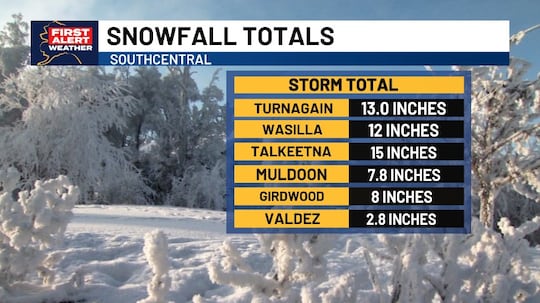Alaska
State: Struggling to attract Outside job seekers, Alaska’s working-age population suffers

ANCHORAGE, Alaska (KTUU) – The Alaska Department of Labor and Workforce Development is looking ahead to a potentially brighter economic picture in the state in 2024, estimating there will be over 5,000 new jobs. But, a big question remains: Will there be enough people to fill those positions?
According to the state, the working-age population, or Alaskans between 18 and 64, continued its downward trend in 2022-23, with an estimated 2% decline. According to a state demographer, since 2013, Alaska has lost 13% of its working-age population — about 33,000 people, more than the population of Juneau — with an aging state population and fewer residents moving to Alaska.
The baby boom population, according to demographer David Howell, is expected to be completely aged out by 2030.
“It’s something that we knew was kind of going to happen,” Howell said.
“It’s not so much that there’s this exodus of people going out of the state, it’s more so that people aren’t coming in,” he added. “We knew that we would see a little bit larger outflows as the baby boomers start to hit those 65 ages, because we’ve always lost populations at the senior age groups. So, numerically, we knew that would happen, but at the working ages [18-64], we’re not really seeing that much more going out, just less coming in.”
Howell said historically, a big chunk of that group was made up of people in their early 20s and 30s. However, now, there is a decline in all age groups moving to the state.
“People are looking for workers all around the country. And so I think people aren’t having to move to find a job, necessarily. And so, you know, if you can kind of stay where you are, and get a job, then, you might just stay where you are,” Howell said.
With a large employment gap in an economy ripe with job openings, Howell said it’s currently an employee market.
The state added in a recent report that Alaska has two job openings for each unemployed job seeker. The decline in the working-age population, Howell said, puts the economy at a standstill.
“We’ve seen areas of the country where the working-age population has stagnated or declined in other years, and, yeah, in general, it does lead to a stagnant economy because you can’t expand that quickly because you don’t have that working population to fill those new jobs,” Howell said.
Jenna Wright, the CEO of the Anchorage Economic Development Corporation, agrees with Howell. She said Anchorage needs to find a way to attract and retain residents to create a thriving economy and help grow back the working-age population. She said investing in infrastructure would be a good start.
“We’ve got great trail systems, we have the beautiful Chugach State Park but we don’t have a ton of access,” Wright said. “All of the parking lots are full right now. So the more that we can invest in quality of life elements that work for a diverse set of people, that’s going to be what’s most important to retaining and attracting talent.”
Copyright 2024 KTUU. All rights reserved.

Alaska
Alaska delegation mixed on Venezuela capture legality, day before presidential war powers vote

ANCHORAGE, Alaska (KTUU) – Alaska’s congressional delegation had mixed reactions Wednesday on the legality of the Trump administration’s actions in Venezuela over the weekend, just a day before they’re set to vote on a bill ending “hostilities” in Venezuela.
It comes days after former Venezuelan Nicolás Maduro was captured by American forces and brought to the United States in handcuffs to face federal drug trafficking charges.
All U.S. Senators were to be briefed by the administration members at 10 a.m. ET Wednesday, including Secretary of State Marco Rubio and Secretary of Defense Pete Hegseth, according to CBS News.
Spokespersons for Alaska Sens. Lisa Murkowski, R-Alaska, and Dan Sullivan, R-Alaska, say they were at that meeting, but from their responses, the two shared different takeaways.
Sullivan, who previously commended the Trump administration for the operation in Venezuela, told KDLL after his briefing that the next steps in Venezuela would be done in three phases.
“One is just stabilization. They don’t want chaos,” he said.
“The second is to have an economic recovery phase … and then finally, the third phase is a transition to conduct free and fair elections and perhaps install the real winner of the 2024 election there, which was not Maduro.”
Murkowski spokesperson Joe Plesha said she had similar takeaways to Sullivan on the ousting of Maduro, but still held concerns on the legality.
“Nicolás Maduro is a dictator who led a brutally oppressive regime, and Venezuela and the world are better places without him in power,” Plesha said in a statement Wednesday. “While [Murkowski] continues to question the legal and policy framework that led to the military operation, the bigger question now is what happens next.”
Thursday, the Senate will decide what happens next when they vote on a war powers resolution which would require congressional approval to “be engaged in hostilities within or against Venezuela,” and directs the president to terminate the use of armed forces against Venezuela, “unless explicitly authorized by a declaration of war or specific authorization for use of military force.”
Several House leaders have also received a briefing from the administration according to CBS News. A spokesperson for Rep. Nick Begich, R-Alaska, said he received a House briefing and left believing the actions taken by the administration were legal.
“The information provided in today’s classified House briefing further confirmed that the actions taken by the Administration to obtain Maduro were necessary, time-dependent, and justified; and I applaud our military and the intelligence community for their exceptional work in executing this operation,” Begich said in a statement.
Looming vote
Sen. Tim Kaine, D-VA, authored the war powers resolution scheduled for debate Thursday at 11 a.m. ET — 7 a.m. AKST.
It’s a resolution which was one of the biggest topics of discussion on the chamber floors Wednesday.
Sen. Rand Paul, R-KY, said on the Senate floor Wednesdya that the actions taken by the administration were an “act of war,” and the president’s capture of Maduro violated the checks and balances established in the constitution, ending his remarks by encouraging his colleagues to vote in favor of the resolution.
“The constitution is clear,” Paul said. “Only Congress can declare a war.”
If all Democrats and independents vote for the Kaine resolution, and Paul keeps to his support, the bill will need three more votes to pass. If there is a tie, the vice president is the deciding vote.
“It’s as if a magical dust of soma has descended through the ventilation systems of congressional office buildings,” Paul continued Wednesday, referring to a particular type of muscle relaxant.
“Vague faces in permanent smiles and obedient applause indicate the degree that the majority party has lost its grip and have become eunuchs in the thrall of presidential domination.”
Legality of actions under scrutiny
U.S. forces arrested Maduro and his wife, Cilia Flores, from their Caracas home in an overnight operation early Saturday morning, Alaska time. Strikes accompanying the capture killed about 75 people, including military personnel and civilians, according to U.S. government officials granted anonymity by The Washington Post.
Maduro pleaded not guilty Monday in a New York courtroom to drug trafficking charges that include leading the “Cartel of the Suns,” a narco-trafficking organization comprised of high-ranking Venezuelan officials. The U.S. offered a $50 million reward for information leading to his capture.
Whether the U.S. was legally able to capture Maduro under both domestic and international law has been scrutinized in the halls of Congress. Members of the administration, like Secretary of State Marco Rubio, have been open in defending what they say was a law enforcement operation carrying out an arrest warrant, The Hill reports. Lawmakers, like Paul or Sen. Chuck Schumer, D-NY, say the actions were an act of war and a violation of the constitution.
While the president controls the military as commander in chief, Congress constitutionally has the power to declare wars. Congressional Democrats have accused Trump of skirting the Constitution by not seeking congressional authorization before the operation.
Murkowski has not outright condemned or supported the actions taken by the administration, saying in a statement she was hopeful the world was safer without Maduro in power, but the way the operation was handled is “important.”
Sullivan, on the other hand, commended Trump and those involved in the operation for forcing Maduro to “face American justice,” in an online statement.
Begich spokesperson Silver Prout told Alaska’s News Source Monday the Congressman believed the operation was “a lawful execution of a valid U.S. arrest warrant on longstanding criminal charges against Nicolás Maduro.”
The legality of U.S. military actions against Venezuela has taken significant focus in Washington over the past several months, highlighted by a “double-tap” strike — a second attack on the same target after an initial strike — which the Washington Post reported killed people clinging to the wreckage of a vessel after the military already struck it. The White House has confirmed the follow-up attack.
Sullivan, who saw classified video of the strike, previously told Alaska’s News Source in December he believed actions taken by the U.S. did not violate international law.
“I support them doing it, but they have to get it right,” he said. “I think so far they’re getting it right.”
Murkowski, who has not seen the video, previously said at an Anchorage press event the takeaways on that strike’s legality seem to be divided along party lines.
“I spoke to a colleague who is on the Intelligence Committee, a Republican, and I spoke to a colleague, a Democrat, who is on the Senate Armed Services Committee … their recollection or their retelling of what they saw [was] vastly different.”
See a spelling or grammar error? Report it to web@ktuu.com
Copyright 2026 KTUU. All rights reserved.
Alaska
National Native helpline for domestic violence and sexual assault to open Alaska-specific service
Alaska
Dozens of vehicle accidents reported, Anchorage after-school activities canceled, as snowfall buries Southcentral Alaska

ANCHORAGE, Alaska (KTUU) – Up to a foot of snow has fallen in areas across Southcentral as of Tuesday, with more expected into Wednesday morning.
All sports and after-school activities — except high school basketball and hockey activities — were canceled Tuesday for the Anchorage School District. The decision was made to allow crews to clear school parking lots and manage traffic for snow removal, district officials said.
“These efforts are critical to ensuring schools can safely remain open [Wednesday],” ASD said in a statement.
The Anchorage Police Department’s accident count for the past two days shows there have been 55 car accidents since Monday, as of 9:45 a.m. Tuesday. In addition, there have been 86 vehicles in distress reported by the department.
The snowfall — which has brought up to 13 inches along areas of Turnagain Arm and 12 inches in Wasilla — is expected to continue Tuesday, according to latest forecast models. Numerous winter weather alerts are in effect, and inland areas of Southcentral could see winds up to 25 mph, with coastal areas potentially seeing winds over 45 mph.
Some areas of Southcentral could see more than 20 inches of snowfall by Wednesday, with the Anchorage and Eagle River Hillsides, as well as the foothills of the Talkeetna Mountain, among the areas seeing the most snowfall.
See a spelling or grammar error? Report it to web@ktuu.com
Copyright 2026 KTUU. All rights reserved.
-

 News1 week ago
News1 week agoFor those who help the poor, 2025 goes down as a year of chaos
-

 Detroit, MI5 days ago
Detroit, MI5 days ago2 hospitalized after shooting on Lodge Freeway in Detroit
-

 Dallas, TX3 days ago
Dallas, TX3 days agoDefensive coordinator candidates who could improve Cowboys’ brutal secondary in 2026
-

 Technology2 days ago
Technology2 days agoPower bank feature creep is out of control
-

 Midwest1 week ago
Midwest1 week agoMcDonald’s locks doors to keep out individuals who present ‘a risk’ in crime-ridden Minneapolis area
-

 West1 week ago
West1 week agoApex predator threatening Northwest salmon sparks rare bipartisan push to ‘kill more’
-

 Southwest1 week ago
Southwest1 week agoMissing 19-year-old Camila Mendoza Olmos believed to be ‘in imminent danger,’ Texas sheriff says
-

 Health4 days ago
Health4 days agoViral New Year reset routine is helping people adopt healthier habits














